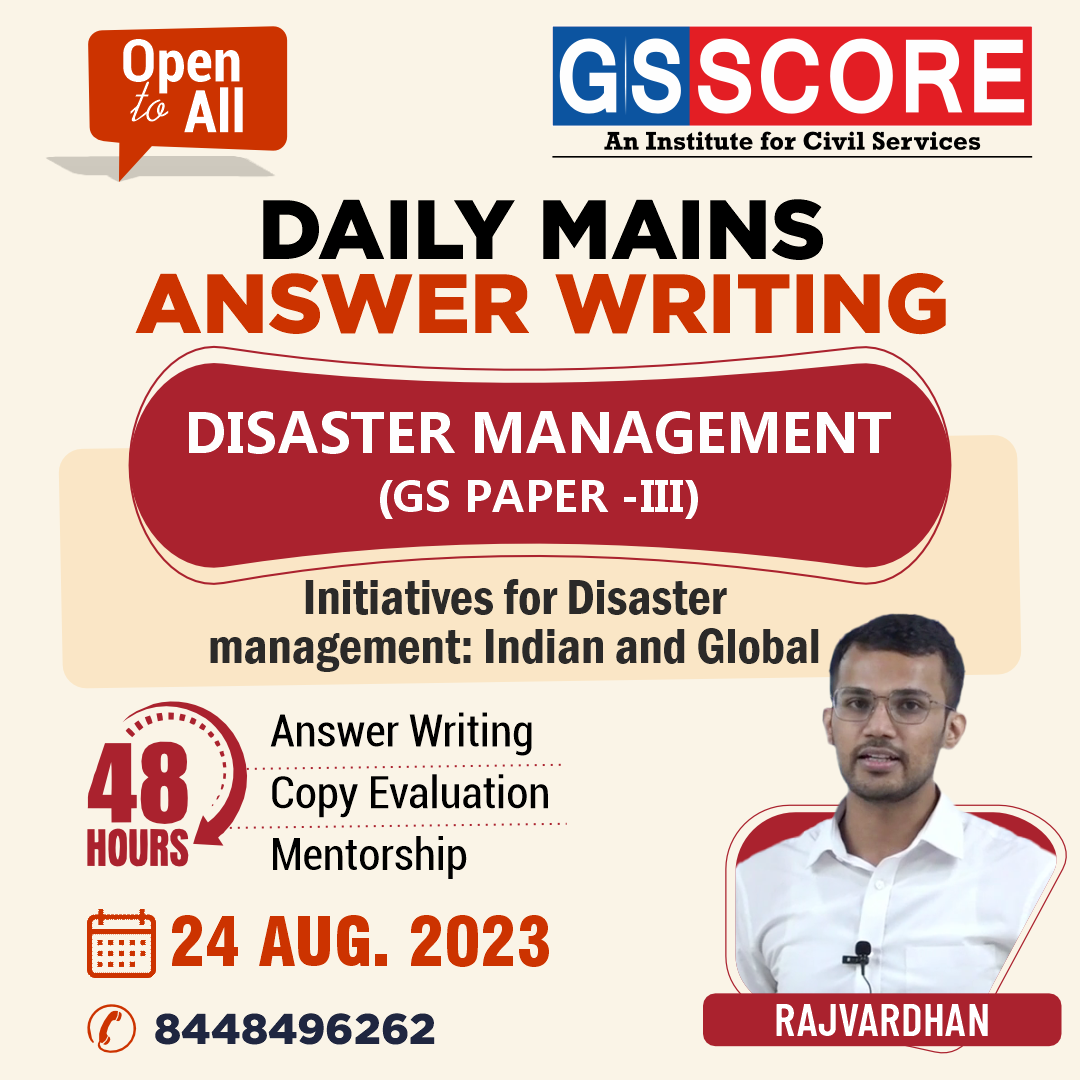


Instruction:
- There will be 2 questions carrying 10 marks each. Write your answers in 150 words
- Any page left blank in the answer-book must be crossed out clearly.
- Evaluated Copy will be re-uploaded on the same thread after 2 days of uploading the copy.
- Discussion of the question and one to one answer improvement session of evaluated copies will be conducted through Google Meet with concerned faculty. You will be informed via mail or SMS for the discussion.
Question #1. Different parts of India are vulnerable to landslides. Discuss the causes and effects of landslides. How National Landslide Risk Management Strategy can help in addressing this vulnerability? (10M)
Question #2. Discuss the priorities under the Sendai Framework for Disaster Risk Reduction. Elaborate its importance in the world with increasing disasters.
(Examiner will pay special attention to the candidate's grasp of his/her material, its relevance to the subject chosen, and to his/ her ability to think constructively and to present his/her ideas concisely, logically and effectively).
STEPS & INSTRUCTIONS for uploading the answers
Step 1 - The Question for the day is provided below these instructions. It will be available at 7:00 AM.
Step 2 - Uploading of Answers : Write the answer in A4 Sheet leaving proper margins for comments and feedback and upload the PDF in MY ACCOUNT section. Click on the option of SUBMIT COPY to upload the PDF.
Step 3 - Deadline for Uploading Answers: The students shall upload their answers by 7:00 PM in the evening same day. The first 50 copies will be evaluated.
Step 4 - Feedback : Mentors will give their feedback for the answers uploaded. For more personalised feedback, join our telegram channel by clicking on the link https://t.me/mains_answer_writing_cse . A one-to-one session will be conducted with the faculty after copy evaluation in 72 Hrs.
Model Answer
Question #1. Different parts of India are vulnerable to landslides. Discuss the causes and effects of landslides. How National Landslide Risk Management Strategy can help in addressing this vulnerability? (10M)
Answer:
Landslide is a sudden movement of mass of rock and debris down the slope. In India landslide occurs in different parts like Himalayas, Western Ghats, North Eastern Region and Andaman and Nicobar Islands.
Landslide zones in India are divided into the following areas –
- Moderate-Low Vulnerable Landslide Zones
- Trans Himalayan region
- Spiti of Himachal Pradesh
- Aravalli mountains
- Deccan Plateau Chhattisgarh Jharkhand Odisha
High Vulnerable Zones
- Northeastern region
- Eastern Ghats
- Konkan Hills
- Nilgiris
Very High Vulnerable Zones
- Andaman and Nicobar Island
- Western Ghats
- Darjeeling
- Sikkim
- Uttarakhand
Causes of Landslides:
- Deforestation
- Shifting Cultivation
- Heavy Rainfall
- Earthquakes
- Developmental projects
- Overgrazing
- Mining
Effects of Landslide:
- Loss of life and property
- Changes course of the river and may lead to floods
- May induce earthquakes
- Affects aesthetics of the region
- Infrastructure is damaged, which halts economic activities
Given these impacts of landslides and due to increasing vulnerability of India to such events, the National Landslide Risk Management Strategy was developed. It focuses on:
- Generation of User-Friendly Landslide Hazard Maps
- Development of Landslide Monitoring and Early Warning System
- Awareness Programmes
- Capacity Building and Training of Stakeholders
- Preparation of Mountain Zone Regulations & Policies
- Stabilization and Mitigation of Landslides and Creation of Special Purpose Vehicle (SPV) for Landslide Management.
Along with this measure it is equally important to address causative factors of landslide. This can be done by afforestation drives, restricting developmental projects in certain areas, terrace farming, developing early warning system. This would help India to prevent and mitigate landslides.
Question #2. Discuss the priorities under the Sendai Framework for Disaster Risk Reduction. Elaborate its importance in the world with increasing disasters.
Answer:
The Sendai Framework for Disaster Risk Reduction 2015-2030 (Sendai Framework) was the first major agreement of the post-2015 development agenda and provides Member States with concrete actions to protect development gains from the risk of disaster.
The areas of priority under the Sendai Framework are:
- Priority 1:
Understanding disaster risk Disaster risk management needs to be based on an understanding of disaster risk in all its dimensions of vulnerability, capacity, exposure of persons and assets, hazard characteristics and the environment
- Priority 2:
Strengthening disaster risk governance to manage disaster risk Disaster risk governance at the national, regional and global levels is vital to the management of disaster risk reduction in all sectors and ensuring the coherence of national and local frameworks of laws, regulations and public policies that, by defining roles and responsibilities, guide, encourage and incentivize the public and private sectors to take action and address disaster risk.
- Priority 3:
Investing in disaster risk reduction for resilience Public and private investment in disaster risk prevention and reduction through structural and non-structural measures are essential to enhance the economic, social, health and cultural resilience of persons, communities, countries and their assets, as well as the environment. These can be drivers of innovation, growth and job creation. Such measures are cost-effective and instrumental to save lives, prevent and reduce losses and ensure effective recovery and rehabilitation.
- Priority 4
Enhancing disaster preparedness for effective response, and to «Build Back Better» in recovery, rehabilitation and reconstruction Experience indicates that disaster preparedness needs to be strengthened for more effective response and ensure capacities are in place for effective recovery. Disasters have also demonstrated that the recovery, rehabilitation and reconstruction phase, which needs to be prepared ahead of the disaster, is an opportunity to «Build Back Better» through integrating disaster risk reduction measures. Women and persons with disabilities should publicly lead and promote gender-equitable and universally accessible approaches during the response and reconstruction phases.
Importance of these priorities in the world with increasing disasters
- Understanding disasters helps us know their causative factors. This would allow us to take preventive and mitigation actions.
- Improvements in the governance at different levels would improve per and post disaster response, this would help us in reducing the intensity and impact of the disaster.
- Investment is needed to implement all the pre, during and post disaster strategies properly. This would help us reduce the impact of disaster.
- Even after taking proper measures to ensure that disasters are prevented, the disaster might occur. In such scenario, when rehabilitation is carried out, it has to be based on ‘ Build Back Better’ principle.
Thus the Sendai Framework for Disaster Risk Reduction has been designed for the world with increasing disasters. Its proper implementation would help us achieve the Sustainable Development Goals.


